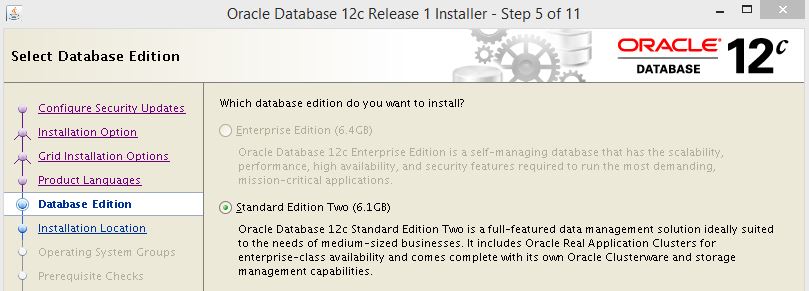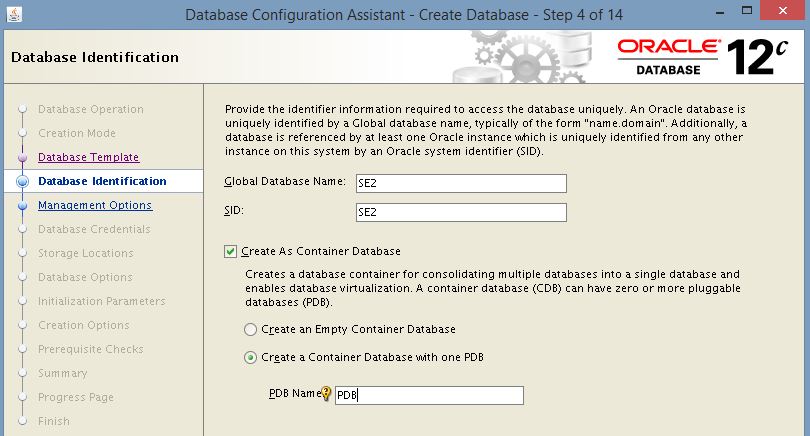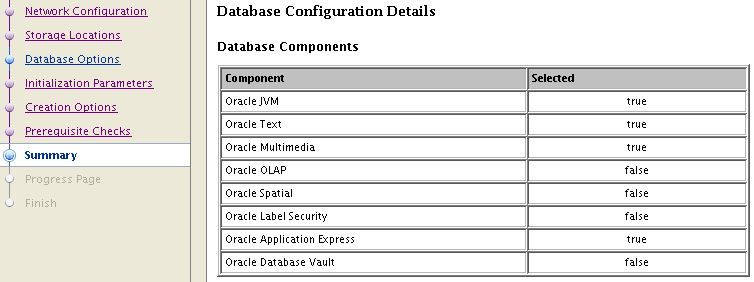By Franck Pachot
.
Look at the Oracle Download page: Standard Edition is there in 12.1.0.2 – more than one year after the release of the patchset for Enterprise Edition. It’s a new name – SE2 in short – and new rules. Let’s have a look at it.
We waited for it after those rumors from July, and as expected we have been notified by from Ann Sjökvist, the Standard Edition lady, on her blog www.sejustloveit.com. And the news are good, as promised by Dominic Giles who has to face so many questions currently…
Installation
So we have a new binary distribution, whith only one possible choice for the edition: Standard Edition Two:
Everything else has nothing special.
Rules
We’re waiting for documentation updates at oracle.com but basically SE2 is limited to 2 sockets, which means that:
- If you have SE on server with 2 sockets, then you can install SE2 without additional cost
- If you have SE on a cluster (RAC) with 2 nodes having 1 socket each, then you an install SE2 without additional cost
- If you have SE One then you have to pay additional fee to go to 12.1.0.2 with SE2
- If you have SE on a cluster (RAC) with 4 nodes having 1 socket each, then you have to remove 2 nodes before going to 12.1.0.2
- If you have SE on a cluster (RAC) with 2 nodes having 2 socket each, then… you have to change hardware before going to 12.1.0.2, remove one socket (physically), or virtualize with OVM
Of course, you can also choose to go to Enterprise Edition and/or in the Oracle Cloud Services…
Apply latest PSU
In the uncompressed p20831110_121020_Linux-x86-64.zip folder I install the JUL2015 PSU
The installation binaries is different, but the PSU is the same as Enterprise Edition
[oracle@VM115 20831110]$ ../../OPatch/opatch apply
Oracle Interim Patch Installer version 12.1.0.1.5
Copyright (c) 2015, Oracle Corporation. All rights reserved.
Oracle Home : /u01/app/oracle/product/12102SE
Central Inventory : /u01/app/oraInventory
from : /u01/app/oracle/product/12102SE/oraInst.loc
OPatch version : 12.1.0.1.5
OUI version : 12.1.0.2.0
Log file location : /u01/app/oracle/product/12102SE/cfgtoollogs/opatch/opatch2015-09-01_21-13-49PM_1.log
Verifying environment and performing prerequisite checks...
OPatch continues with these patches: 19769480 20299023 20831110
Do you want to proceed? [y|n]
Create Database
At that point you can upgrade a 12.1.0.1 database or create a new one.
I run DBCA in advanced mode. You remember that non-CDB is deprecated? Then choose container database. Of course you can’t choose the number of PDBs to create here. You are in Standard Edition: it’s single tenant. Only one PDB.
The ‘database options’ step has been skipped. You don’t choose. You install a CDB with all options allowed in SE.
and here is my database:
$ sqlplus / as sysdba
SQL*Plus: Release 12.1.0.2.0 Production on Tue Sep 1 21:06:23 2015
Copyright (c) 1982, 2014, Oracle. All rights reserved.
Connected to:
Oracle Database 12c Standard Edition Release 12.1.0.2.0 - 64bit Production
SQL>
datapatch
If you have read Mike Dietrich post on dbca and datapatch, you know that you have to run datapatch after DBCA or DBUA.
$ $ORACLE_HOME/OPatch/datapatch -verbose
SQL Patching tool version 12.1.0.2.0 on Tue Sep 1 21:21:00 2015
Copyright (c) 2015, Oracle. All rights reserved.
Log file for this invocation: /u01/app/oracle/cfgtoollogs/sqlpatch/sqlpatch_5954_2015_09_01_21_21_00/sqlpatch_invocation.log
Connecting to database...OK
Note: Datapatch will only apply or rollback SQL fixes for PDBs
that are in an open state, no patches will be applied to closed PDBs.
Please refer to Note: Datapatch: Database 12c Post Patch SQL Automation
(Doc ID 1585822.1)
Bootstrapping registry and package to current versions...done
Determining current state...done
Current state of SQL patches:
Bundle series PSU:
ID 4 in the binary registry and not installed in any PDB
Adding patches to installation queue and performing prereq checks...
Installation queue:
For the following PDBs: CDB$ROOT PDB$SEED
Nothing to roll back
The following patches will be applied:
20831110 (Database Patch Set Update : 12.1.0.2.4 (20831110))
Installing patches...
Patch installation complete. Total patches installed: 2
Validating logfiles...
Patch 20831110 apply (pdb CDB$ROOT): SUCCESS
logfile: /u01/app/oracle/cfgtoollogs/sqlpatch/20831110/18977826/20831110_apply_SE2_CDBROOT_2015Sep01_21_21_48.log (no errors)
Patch 20831110 apply (pdb PDB$SEED): SUCCESS
logfile: /u01/app/oracle/cfgtoollogs/sqlpatch/20831110/18977826/20831110_apply_SE2_PDBSEED_2015Sep01_21_21_55.log (no errors)
SQL Patching tool complete on Tue Sep 1 21:22:01 2015
Oh. I forgot that my pluggable database is closed…
SQL> alter pluggable database pdb open;
Warning: PDB altered with errors.
then running datapatch again:
Installing patches...
Patch installation complete. Total patches installed: 1
Validating logfiles...
Patch 20831110 apply (pdb PDB): SUCCESS
logfile: /u01/app/oracle/cfgtoollogs/sqlpatch/20831110/18977826/20831110_apply_SE2_PDB_2015Sep01_21_28_11.log (no errors)
SQL Patching tool complete on Tue Sep 1 21:28:17 2015
Thread limitation
I’m on a VM with only 4 cores here. Let’s run 20 session all in CPU anyway, by running 20 times the following:
(
TWO_TASK=//vm115/PDB sqlplus sys/oracle as sysdba <<END
alter session set plsql_optimize_level=0;
exec loop null; end loop;
END
)&
Here is the top screen while running:
top - 21:58:17 up 1:09, 3 users, load average: 4.34, 4.45, 2.82
Tasks: 199 total, 5 running, 194 sleeping, 0 stopped, 0 zombie
%Cpu(s): 99.7 us, 0.1 sy, 0.0 ni, 0.0 id, 0.0 wa, 0.0 hi, 0.2 si, 0.0 st
KiB Mem: 1018372 total, 1008288 used, 10084 free, 568 buffers
KiB Swap: 1257468 total, 97252 used, 1160216 free. 103572 cached Mem
PID USER PR NI VIRT RES SHR S %CPU %MEM TIME+ COMMAND
8145 oracle 20 0 1032592 8000 5700 R 21.9 0.8 2:14.05 oracle_8145_se2
8118 oracle 20 0 1032596 8004 5704 S 20.6 0.8 2:20.59 oracle_8118_se2
8148 oracle 20 0 1032592 8016 5720 S 20.6 0.8 2:13.43 oracle_8148_se2
8103 oracle 20 0 1032596 7996 5688 S 20.3 0.8 2:30.29 oracle_8103_se2
8112 oracle 20 0 1032596 8168 5868 S 20.3 0.8 2:23.69 oracle_8112_se2
8130 oracle 20 0 1032596 8008 5704 S 20.3 0.8 2:16.14 oracle_8130_se2
8133 oracle 20 0 1032592 8020 5720 S 20.3 0.8 2:14.40 oracle_8133_se2
8151 oracle 20 0 1032596 8008 5708 S 20.3 0.8 2:13.41 oracle_8151_se2
8154 oracle 20 0 1032592 8032 5732 S 20.3 0.8 2:11.76 oracle_8154_se2
8136 oracle 20 0 1032592 8004 5704 S 19.9 0.8 2:14.70 oracle_8136_se2
8139 oracle 20 0 1032596 8008 5704 S 19.9 0.8 2:14.92 oracle_8139_se2
8106 oracle 20 0 1032592 7980 5680 R 19.6 0.8 2:28.44 oracle_8106_se2
8121 oracle 20 0 1032600 7976 5668 S 19.6 0.8 2:19.45 oracle_8121_se2
8142 oracle 20 0 1032596 8016 5716 R 19.6 0.8 2:13.60 oracle_8142_se2
8157 oracle 20 0 1032596 8000 5700 R 19.6 0.8 2:12.65 oracle_8157_se2
8160 oracle 20 0 1032592 8488 6188 S 19.6 0.8 2:12.62 oracle_8160_se2
8115 oracle 20 0 1032596 7980 5676 S 19.3 0.8 2:21.39 oracle_8115_se2
8127 oracle 20 0 1032596 7984 5684 S 19.3 0.8 2:18.06 oracle_8127_se2
8109 oracle 20 0 1032596 8164 5860 S 18.9 0.8 2:26.49 oracle_8109_se2
8124 oracle 20 0 1032596 8008 5708 S 18.9 0.8 2:17.93 oracle_8124_se2
5792 oracle 20 0 1041576 109364 99516 S 0.3 10.7 0:07.97 ora_cjq0_se2
Look at the load average: it’s 4. It seems that the database itself has limited the number of processes willing to run in CPU.
That looks like Resource manager instance caging.
We usually think that we need to have a resource manager plan and set explicitely the cpu_count for that, but that’s not the case here:
SQL> show spparameter cpu_count
SID NAME TYPE VALUE
-------- ----------------------------- ----------- ----------------------------
* cpu_count integer
SQL> show spparameter resource
SID NAME TYPE VALUE
-------- ----------------------------- ----------- ----------------------------
* resource_manager_plan string
Anyway, in Standard Edition, the resource manager is not usable:
SQL> alter system set resource_manager_plan=DEFAULT;
alter system set resource_manager_plan=DEFAULT
*
ERROR at line 1:
ORA-02097: parameter cannot be modified because specified value is invalid
ORA-00439: feature not enabled: Database resource manager
However when I check Statspack report for my 20 sessions run:
Snapshot Snap Id Snap Time Sessions Curs/Sess Comment
~~~~~~~~ ---------- ------------------ -------- --------- ------------------
Begin Snap: 3 01-Sep-15 21:47:37 22 1.4
End Snap: 11 01-Sep-15 21:54:05 24 2.5
Elapsed: 6.47 (mins) Av Act Sess: 19.5
DB time: 126.27 (mins) DB CPU: 24.10 (mins)
...
Load Profile Per Second Per Transaction Per Exec Per Call
~~~~~~~~~~~~ ------------------ ----------------- ----------- -----------
DB time(s): 19.5 315.7 0.48 25.00
DB CPU(s): 3.7 60.3 0.09 4.77
...
Top 5 Timed Events Avg %Total
~~~~~~~~~~~~~~~~~~ wait Call
Event Waits Time (s) (ms) Time
----------------------------------------- ------------ ----------- ------ ------
resmgr:cpu quantum 14,987 6,114 408 99.7
CPU time 12 .2
db file sequential read 862 6 7 .1
log file sync 18 1 57 .0
Disk file operations I/O 204 0 2 .0
-------------------------------------------------------------
I have on average 3.7 sessions in CPU (roughly the load average at OS level), a total of 19.5 average active session (my 20 sessions looping in CPU). And 6,114/(6.47*60)=15.7 sessions waiting on ‘resmgr:cpu quantum’
What happens then? Like in XE (where limit is 1 thread), the resource manager is used internally. I’ve not enough cpu here to show it, but the limit for Standard Edition is 16 foreground session active in CPU at maximum. All that will be documented soon. Big thanks to Dominic Giles for sharing with us.
Remark: that 15.7 has nothing to do with the thread limit of 16 – it’s just my 20 sessions minus my 4 cpu. We can see the limit of 16 only when we have more than 16 cores
update: Of course, this 16 threads per database is 8 threads per server when in RAC (remember that you can’t have more than two nodes).
Pricing, features and support
The price and features is the same as the Standard Edition (pricelist, features) that we know.
update: One thing change if you are in NUP. The minimum that was 5 NUP, is now 10 NUP and is per server.
The 12.1.0.1 is supported until August 2016 (MOS Doc ID 2027072.1) but don’t wait: 12.1.0.2 has new features even for Standard Edition (more on that soon), and lot of bugs fixed.



![Thumbnail [60x60]](https://www.dbi-services.com/blog/wp-content/uploads/2022/12/oracle-square.png)
![Thumbnail [90x90]](https://www.dbi-services.com/blog/wp-content/uploads/2022/10/STS_web-min-scaled.jpg)
![Thumbnail [90x90]](https://www.dbi-services.com/blog/wp-content/uploads/2022/08/STH_web-min-scaled.jpg)
![Thumbnail [90x90]](https://www.dbi-services.com/blog/wp-content/uploads/2022/09/SNA_web-min-scaled.jpg)